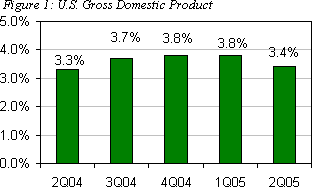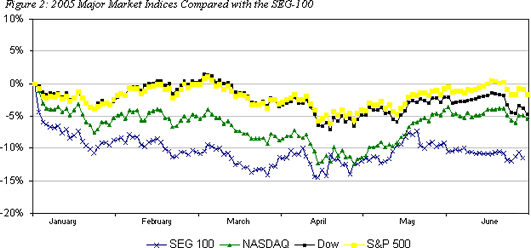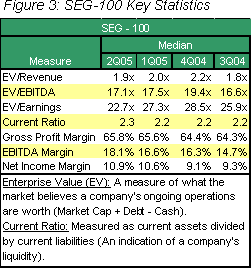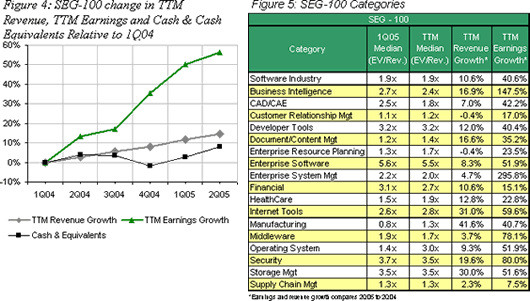By Ken Bender and Allen Cinzori, Software Equity Group, LLC
Economy
 Despite high-energy prices, "froth" in the housing market and record trade deficits, the U.S. economy, which is nearing its fifth year of expansion, continued to improve in the second quarter of 2005. Gross Domestic Product (GDP), a key economic indicator and broadest measure of economic activity, is projected to grow at an annualized rate of 3.2% in 2Q05. First quarter GDP was revised upward by 0.7% to 3.8% (Figure 1). According to a midyear survey of 56 forecasters by The Wall Street Journal, economists are cautiously optimistic about the economy for the second half of the year, projecting 3.5% growth. Personal consumption, exports, private investment, and equipment and software expenditures are likely to be the key drivers. Equipment and software spending, a component of GDP that is primarily IT related, increased 6.1% in 1Q05 and 13.6% in 2004. Despite high-energy prices, "froth" in the housing market and record trade deficits, the U.S. economy, which is nearing its fifth year of expansion, continued to improve in the second quarter of 2005. Gross Domestic Product (GDP), a key economic indicator and broadest measure of economic activity, is projected to grow at an annualized rate of 3.2% in 2Q05. First quarter GDP was revised upward by 0.7% to 3.8% (Figure 1). According to a midyear survey of 56 forecasters by The Wall Street Journal, economists are cautiously optimistic about the economy for the second half of the year, projecting 3.5% growth. Personal consumption, exports, private investment, and equipment and software expenditures are likely to be the key drivers. Equipment and software spending, a component of GDP that is primarily IT related, increased 6.1% in 1Q05 and 13.6% in 2004.
The Conference Board's index of leading economic indicators, which gauges the economy's likely performance over the next three to six months, paints a less optimistic picture. The index, which declined 0.5% in May, has declined at a 2.2% annual rate over the last six months, and 1.9% over the last twelve months. Only one in ten indicators that comprise the leading index increased in May. The positive contributor was stock prices. The negative contributors - beginning with the largest negative contributor - were interest rate spread, average weekly initial claims for unemployment insurance, building permits, vendor performance, average weekly manufacturing hours, index of consumer expectations, manufacturers" new orders for nondefense capital goods, real money supply, and manufacturers" new orders for consumer goods and materials. Last year at this time, the index forecasted a robust economy and continued expansion - advancing 13 times in 14 consecutive months.
Staying the course to keep inflation at bay, the Federal Reserve raised the Federal Funds rate 25 basis points to 3.25% at the end of 2Q05 - the 9th increase in twelve months. The Fed continues to believe economic expansion continues at a measurable rate. Surprisingly, the Fed's rate increases have had no impact on long-term rates - a concern for many Fed officials who believe low mortgage rates have lifted real estate prices to unsustainable levels.
The unemployment rate dipped in June to 5%, providing support for the Fed's claim that the economy is in good shape. The June unemployment rate is down from 5.1% in May, and is at its lowest level since September 2001. For 1H05, job growth has averaged 181,000 a month. Wall Street Journal economists expect similar job growth for the next year.

 Public Market and Public Software Company Performance Public Market and Public Software Company Performance
Public markets continued to reflect investor uneasiness in the first half of 2005. U.S. Markets are still not out of the red with the Dow, NASDAQ, and S&P 500 down 4.7%, 5.5%, and 1.7%, respectively, from the beginning of the year (Figure 2). In 2Q05, the Dow was down 1.2%, although the NASDAQ and S&P 500 posted gains of 3.6%, and 0.9%, respectively, compared to the end of 1Q05. Market Caps of the SEG-100, our index of public software companies, showed signs of strength during much of the second quarter, but back slid by the quarter's end, posting a modest 1.6% improvement over the close of the first quarter, and down 11.5% from January 1. Other key 2Q05 measures for the SEG-100, including comparisons with the prior quarter, are enumerated in Figure 3.
In a trailing-twelve-month (TTM) revenue basis, overall financial performance of the SEG-100 continued to improve. Median TTM revenue relative to a Q1 2004 base year is up 14.4%, while TTM earnings relative to the same base period has skyrocketed 56.5%.

Cash and cash equivalents also increased over the same time period, an obvious byproduct of an improving bottom line (Figures 4). Since 2002, public software companies have been focusing resolutely on cost cutting and earnings improvement as a means of retaining investor confidence despite stagnant revenue growth. Having done so, most public software companies have begun to shift focus to top line growth, both organically and through mergers and acquisitions. For the balance of 2005, expect to see more deals along the lines of Symantec/Veritas, Computer Associates/ Netegrity, Oracle/Retek, IBM/Assential and Oracle/Peoplesoft are some of the more notable examples of an M&A driven revenue enhancement strategy.
...more...
|

